The Application of Auxin-like Compounds Promotes Cold Acclimation in the Oilseed Rape Plant
Abstract
1. Introduction
2. Materials and Methods
2.1. Object of Research
2.2. Field Experiments
2.3. Extraction of Easily Soluble Protein (ESP) and Heavily Soluble Protein (HSP) Fractions and Thermostable Proteins
2.4. Analysis and Identification of Protein Preparations Using Electrophoresis Methods
2.5. Identification of Dehydrins Using Immunoblotting Method
2.6. Extraction of Free IAA and IAA Conjugates and Other Metabolites
2.7. Characterization and Identification of IAA and Its Conjugates
2.8. Statistical Analysis
3. Results
3.1. Changes in the Number of Proteins during the Autumn Growth Period and the Various Stages of Cold Acclimation
3.2. Characteristics of the Differing Protein Metabolic Processes in the Oilseed Rape Cultivars According to Their Resistance to Wintering at the End of Cold Acclimation Period
3.3. Peculiarities of the Changes in Proteins Composition of the Two Oilseed Rape Cultivars That Differ According to Their Resistance to Wintering
3.4. Number of Polypeptides in the Oilseed Rape Cultivars with Different Resistance to Wintering during the Cold Acclimation Period
3.5. Characterization of Thermostable Proteins Found in the Oilseed Rape Cultivars Different for Their Resistance to Wintering during the Cold Acclimation and Preparation to Wintering Period
3.6. Identification of the Specific Thermostable Proteins-Dehydrins by the Western Blotting Method
3.7. Influence of Auxin Physiological Analogues on Protein Composition in the Oilseed Rape Cultivars ‘Casino’ and ‘Valesca’ during the Cold Acclimation Period
3.8. Influence of Auxin-like Compounds on Protein Composition in the Oilseed Rape Cultivars ‘Casino’ and ‘Valesca’ during the Cold Acclimation Period
3.9. Amount and Status of Phytohormone IAA and Peculiarities of Its Changes in the Oilseed Rape Cultivars Different for Their Resistance to Wintering during the Autumn Growth and at the End of the Cold Acclimation Period
3.9.1. Amount and Status of Phytohormone IAA during the Autumn Growth Period
3.9.2. Amount and Status of IAA in the Early Period of Cold Acclimation
3.9.3. Amount and Status of IAA in the Late Period of Cold Acclimation
3.9.4. Amount and Status of IAA at the End of the Cold Acclimation Period
3.9.5. Final Identification of IAA and Metabolites in the Oilseed Rape Plants
3.10. Influence of the Auxin-like Compounds TA-12 and TA-14 on the Amount and Status of the IAA
3.11. Influence of Auxin-like Compounds on Biometric Parameters and Overwintering
4. Discussion
4.1. Relationship between Auxin-like Compounds TA-12 and TA-14 and Protein Metabolism Reorganization and Oilseed Rape Cold Acclimation
4.2. The Influence of Auxin-like Compounds TA-12 and TA-14 on IAA Metabolism and Their Relationship with Oilseed Rape Cold Acclimation
5. Conclusions
Author Contributions
Funding
Institutional Review Board Statement
Informed Consent Statement
Data Availability Statement
Conflicts of Interest
References
- Hughes, M.A.; Dunn, M.A. The molecular biology of plant acclimation to low temperature. J. Plant Exp. Bot. 1996, 47, 291–305. [Google Scholar] [CrossRef]
- Wang, Q.; Cheng, T.; Yu, X.; Teixeira da Silva, J.A.; Byrne, D.H. Physiological and biochemical responses of six herbaceous peony cultivars to cold stress. S. Afr. J. Bot. 2014, 94, 140–148. [Google Scholar] [CrossRef]
- Ouyang, L.; Leus, L.; De Keyser, E.; Van Labeke, M.C. Cold Acclimation and Deacclimation of Two Garden Rose Cultivars Under Controlled Daylength and Temperature. Front. Plant Sci. 2020, 11, 327. [Google Scholar] [CrossRef] [PubMed]
- Horvath, D.P.; Anderson, J.V.; Chao, W.S.; Foley, M.E. Knowing when to grow: Signals regulating bud dormancy. Trends Plant Sci. 2003, 8, 534–540. [Google Scholar] [CrossRef] [PubMed]
- Gusta, L.V.; Trischuk, R.; Weiser, C.J. Plant cold acclimation: Role of abscisic acid. J. Plant Growth Regul. 2005, 2, 308–318. [Google Scholar] [CrossRef]
- Catalá, C.; Medina, J.; Salinas, J. Integration of low temperature and light signaling during cold acclimation response in Arabidopsis. Proc. Natl. Acad. Sci. USA 2011, 108, 16475–16480. [Google Scholar] [CrossRef] [PubMed]
- Velička, R.; Pupalienė, R.; Butkevičienė, L.M.; Kriaučiūnienė, Z. Peculiarities of overwintering of hybrids and conventional cultivars of winter rapeseed depending on the sowing date. Acta Sci. Pol. Agric. 2012, 11, 53–66. [Google Scholar]
- Boinot, M.; Karakas, E.; Koehl, K.; Pagter, M.; Zuther, E. Cold stress and freezing tolerance negatively affect the fitness of Arabidopsis thaliana accessions under field and controlled conditions. Planta 2022, 255, 39. [Google Scholar] [CrossRef]
- Thomashow, M.F. Plant cold acclimation: Freezing tolerance genes a regulatory mechanisms. Annu. Rev. Plant Physiol. Plant Mol. Biol. 1999, 50, 571–599. [Google Scholar] [CrossRef] [PubMed]
- Olsen, J.E. Light and temperature sensing and signaling in induction of bud dormancy in woody plants. Plant Mol. Biol. 2010, 73, 37–47. [Google Scholar] [CrossRef] [PubMed]
- Fürtauer, L.; Weiszmann, J.; Weckwerth, W.; Nägele, T. Dynamics of Plant Metabolism during Cold Acclimation. Int. J. Mol. Sci. 2019, 20, 5411. [Google Scholar] [CrossRef] [PubMed]
- Yuanyuan, M.; Yali, Z.; Jiang, L.; Hongbo, S. Roles of plant soluble sugars and their responses to plant cold stress. Afr. J. Biotechnol. 2009, 8, 2004–2010. [Google Scholar]
- Espevig, T.; DaCosta, M.; Hoffman, L.; Aamlid, T.S.; Tronsmo, A.M.; Clarke, B.B.; Huang, B. Freezing Tolerance and Carbohydrate Changes of Two Agrostis Species during Cold Acclimation. Crop Sci. 2011, 51, 1188–1197. [Google Scholar] [CrossRef]
- Nägele, T.; Heyer, A.G. Approximating subcellular organisation of carbohydrate metabolism during cold acclimation in different natural accessions of Arabidropsis thaliana. New Phytol. 2013, 198, 777–787. [Google Scholar] [CrossRef]
- Fowler, S.; Thomashow, M. Arabidopsis Transcriptome Profiling Indicates That Multiple Regulatory Pathways Are Activated during Cold Acclimation in Addition to the CBF Cold Response Pathway. Plant Cell 2002, 14, 1675–1690. [Google Scholar] [CrossRef]
- Welling, A.; Kaikuranta, P.; Rinne, P. Photoperiodic induction of dormancy and freezing tolerance in Betula pubescens. Involvement of ABA and dehydrins. Physiol. Plant. 1997, 100, 119–125. [Google Scholar] [CrossRef]
- Welling, A.; Moritz, T.; Palva, E.T.; Junttila, O. Independent activation of cold acclimation by low temperature and short photoperiod in hybrid Aspen. Plant Physiol. 2002, 129, 1633–1641. [Google Scholar] [CrossRef]
- Borovskii, G.B.; Stupnikova, I.V.; Antipina, A.I.; Voinikov, V.K. Accumulation of Dehydrins and ABA-Inducible Proteins in Wheat Seedlings during Low-Temperature Acclimation. Russ. J. Plant Physiol. 2002, 49, 229–234. [Google Scholar] [CrossRef]
- Huang, X.; Shi, H.; Hu, Z.; Liu, A.; Amombo, E.; Chen, L.; Fu, J. ABA Is Involved in Regulation of Cold Stress Response in Bermudagrass. Front. Plant Sci. 2017, 8, 1613. [Google Scholar] [CrossRef]
- Vanneste, S.; Friml, J. Auxin: A trigger for change in plant development. Cell 2009, 136, 1005–1016. [Google Scholar] [CrossRef]
- Benkova, E.; Ivanchenko, M.G.; Friml, J.; Shishkova, S.; Dubrovsky, J.G. A morphogenetic trigger: Is there an emerging concept in plant developmental biology? Trends Plant Sci. 2009, 14, 189–193. [Google Scholar] [CrossRef] [PubMed]
- Li, C.; Junttila, O.; Ernstesn, A.; Heino, P.; Palva, E.T. Photoperiodic control of growth, cold acclimation and dormancy development in silver birch (Betula pendula) ecotypes. Physiol. Plant. 2003, 117, 206–212. [Google Scholar] [CrossRef]
- Kosová, K.; Prášil, I.T.; Vítámvás, P.; Dobrev, P.; Motyka, V.; Flaková, K.; Novák, O.; Turečková, V.; Rolčik, J.; Pešek, B.; et al. Complex phytohormone responses during the cold acclimation of two wheat cultivars differing in cold tolerance, winter Samanta and spring Sandra. J. Plant Physiol. 2012, 169, 567–576. [Google Scholar] [CrossRef] [PubMed]
- Parmentier-Line, C.M.; Pant, G.R.; Rowland, L.J. Changes in dehydrin expression associated with cold, ARBA and PEG treatments in blueberry cell culture. Plant Sci. 2002, 162, 273–282. [Google Scholar] [CrossRef]
- Marian, C.O.; Eris, A.; Krebs, S.L.; Arora, R. Enviromental regulation of a 25 kDa dehydrins in relation to Rhododendron cold accliamtion. J. Am. Soc. Hortic. Sci. 2004, 129, 354–359. [Google Scholar] [CrossRef][Green Version]
- Yuan, L.; Xie, S.; Nie, L.; Zheng, Y.; Wang, J.; Huang, J.; Zhao, M.; Zhu, S.; Hou, J.; Chen, G.; et al. Comparative Proteomics Reveals Cold Acclimation Machinery Through Enhanced Carbohydrate and Amino Acid Metabolism in Wucai (Brassica campestris L.). Plants 2019, 8, 474. [Google Scholar] [CrossRef]
- Gillespie, L.M.; Volaire, F.A. Are winter and summer dormancy symmetrical seasonal adaptive strategies? The case of temperate herbaceous perennials. Ann. Bot. 2017, 119, 311–323. [Google Scholar] [CrossRef]
- Kurepin, L.V.; Dahal, K.P.; Savitch, L.V.; Singh, J.; Bode, R.; Ivanov, A.G.; Hurry, V.; Hüner, N.P.A. Role of CBFa as Integrators of Chloroplast Redox, Phytochrome and Plant Hormone Signaling during Cold Acclimation. Int. J. Mol. Sci. 2013, 14, 12729–12763. [Google Scholar] [CrossRef]
- Kosová, K.; Klíma, M.; Prášil, I.T.; Vítámvás, P. COR/LEA Proteins as Indicators of Frost Tolerance in Triticeae: A Comparison of Controlled versus Field Conditions. Plants 2021, 10, 789. [Google Scholar] [CrossRef]
- Jaškūnė, K.; Armonienienė, R.; Liatukas, Ž.; Statkevičiūtė, G.; Cesevičienė, J.; Brazauskas, G. Relationship between Freezing Tolerance and Leaf Growth during Acclimation in Winter Wheat. Agronomy 2022, 12, 859. [Google Scholar] [CrossRef]
- Kosmala, A.; Bocian, A.; Rapacz, M.; Jurczyk, B.; Zwierzykowski, Z. Identification of leaf proteins differentially accumulated during cold acclimation between Festuca pratensis plants with distinct levels of frost tolerance. J. Exp. Bot. 2010, 60, 3595–3609. [Google Scholar] [CrossRef] [PubMed]
- Gavelienė, V.; Novickienė, L.; Pakalniškytė, L. Effect of auxin physiological analogues on rapeseed (Brassica napus) cold hardening, seed yield and quality. J. Plant Res. 2013, 126, 283–292. [Google Scholar] [CrossRef] [PubMed]
- Liu, J.H.; Kitashiba, H.; Wang, J.; Ban, Y.; Moriguchi, T. Polyamines and their ability to provide environmental stress tolerance to plants. Plant Biotechnol. 2007, 24, 117–126. [Google Scholar] [CrossRef]
- Hayat, S.; Hayat, Q.; Alyemeni, M.N.; Wani, A.S.; Pichtel, J.; Ahmad, A. Role of proline under changing environments. Plant Signal. Behav. 2012, 7, 1456–1466. [Google Scholar] [CrossRef] [PubMed]
- Yang, W.; Cai, T.; Ni, Y.; Li, Y.; Guo, J.; Peng, D.; Yang, D.; Yin, Y.; Wang, Z. Effects of exogenous abscisic acid and gibberellic acid on flling process and nitrogen metabolism characteristics in wheat grains. Aust. J. Crop Sci. 2013, 7, 58–65. [Google Scholar]
- Ebeed, H.T.; Hassan, N.M.; Aljarani, A.M. Exogenous applications of polyamines modulate drought responses in wheat through osmolytes accumulation, increasing free polyamine levels and regulations of polyamine biosynthetic genes. Plant Physiol. Biochem. 2017, 118, 438–448. [Google Scholar] [CrossRef]
- Gavelienė, V.; Pakalniškytė, L.; Novickienė, L.; Balčiauskas, L. Effect of biostimulants on cold resistance and productivity formation in winter rapeseed and winter wheat. Ir. J. Agric. Food Res. 2018, 57, 71–83. Available online: https://www.jstor.org/stable/26555013 (accessed on 15 July 2022). [CrossRef]
- Schubert, M.; Groenvold, L.; Sandve, S.R.; Hvidsten, T.R.; Fjellheim, S. Evolution of cold acclimation and its role in niche transition in the temperate grass subfamily Pooideae. Plant Physiol. 2019, 180, 404–419. [Google Scholar] [CrossRef]
- Woźniak, E.; Waszkowska, E.; Zimny, T.; Sowa, S.; Twardowski, T. The Rapeseed Potential in Poland and Germany in the Context of Production, Legislation, and Intellectual Property Rights. Front. Plant Sci. 2019, 10, 1423. [Google Scholar] [CrossRef]
- Raza, A.; Razzaq, A.; Mehmood, S.; Zou, X.; Zhang, X.; Lv, Y.; Xu, J. Impact of Climate Change on Crops Adaptation and Strategies to Tackle Its Outcome: A Review. Plants 2019, 8, 34. [Google Scholar] [CrossRef]
- OECD-FAO Agricultural Outlook 2021–2030. Available online: https://www.oecd-ilibrary.org/ (accessed on 10 June 2022).
- Velička, R.; Anisimovienė, N.; Pupalienė, R.; Jankauskienė, J.; Butkevičienė, L.M.; Kriaučiūnienė, Z. Preparation of oilseed rape for over-wintering according to autumnal growth and cold acclimation. Zemdirb. Agric. 2010, 97, 69–76. [Google Scholar]
- Novickienė, L.; Gavelienė, V. Modification pf spring rape growth and morphogenesis by physiological analogues of auxin. Sodinink. Daržinink. 2000, 19, 180–192. [Google Scholar]
- Anisimovienė, N.; Novickienė, L.; Jankauskienė, J. Cold acclimation of winter rape: Changes in protein composition under the effect of auxin analogue TA-14. Žemdirbystė 2004, 2, 30–38. [Google Scholar]
- Kosová, K.; Holková, L.; Prášil, I.T.; Prášilová, P.; Brádačóvá, M.; Vítámvas, P.; Čapková, V. Expression of dehydrin 5 during the development of frost tolerance in barley (Hordeum vulgare). J. Plant Physiol. 2008, 165, 1142–1151. [Google Scholar] [CrossRef] [PubMed]
- Bradford, M.M. A rapid sensitive method fot the quantification of microgram quantities of protein utilizing the principle of protein-dye binding. Anal. Biochem. 1976, 72, 248–254. [Google Scholar] [CrossRef]
- Vítámvás, P.; Saalbach, G.; Prášil, I.P.; Čapková, V.; Opatrná, J.; Ahmed, J. WCS120 protein family and proteins soluble upon boiling in cold-acclimated winter wheat. J. Plant Physiol. 2007, 164, 1197–1207. [Google Scholar] [CrossRef] [PubMed]
- Close, T.J.; Fenton, R.D.; Moonan, F. A view of plant dehydrins using antibodies specific to the carboxy terminal peptide. Plant Mol. Biol. 1993, 23, 279–286. [Google Scholar] [CrossRef]
- Bajguz, A.; Piotrowska, A. Conjugates of auxin and cytokinin. Phytochemistry 2009, 70, 957–969. [Google Scholar] [CrossRef]
- Normanly, J. Approaching Cellular and Molecular Resolution of Auxin Biosynthesis and Metabolism. Cold Spring Harb. Perspect. Biol. 2010, 2, a001594. [Google Scholar] [CrossRef] [PubMed]
- Porfírio, S.; da Silva, M.D.R.G.; Peixe, A.; Cabrita, M.J.; Azadi, P. Current analytical methods for plant auxin quantification—A review. Anal. Chim. Acta 2016, 902, 8–21. [Google Scholar] [CrossRef] [PubMed]
- Kowalczyk, M.; Sandberg, G. Quantitative analysis of indole-3-acetic acid metabolites of Arabidopsis. Plant Physiol. 2001, 127, 1845–1853. [Google Scholar] [CrossRef]
- Colton-Gagnon, K.; Ali-Benali, M.A.; Mayer, B.F.; Dione, R.; Bertrand, A.; Do Cormo, S.; Charron, J.-B. Comparative analysis of the cold acclimation and freezing tolerance capacities of seven diploid Brachypodium distachyon accessions. Ann. Bot. 2013, 113, 681–693. [Google Scholar] [CrossRef] [PubMed]
- Prerostova, S.; Zupkova, B.; Petrik, I.; Simura, J.; Nasinec, I.; Kopecky, D.; Knirsch, V.; Gaudinova, A.; Novak, O.; Vankova, R. Hormonal responses associated with acclimation to freezing stress in Lolium perenne. Environ. Exp. Bot. 2021, 182, 104295. [Google Scholar] [CrossRef]
- Pan, X.; Guan, L.; Lei, K.; Li, J.; Zhang, X. Transcriptional and physiological data revealed cold tolerance in a photo-thermo sensitive genic male sterile line Yu17S. BMC Plant Biol. 2022, 22, 44. [Google Scholar] [CrossRef] [PubMed]
- Takahashi, D.; Kawamura, Y.; Uemura, M. Cold acclimation is accompanied by complex responses of glycosylphosphatidylinositol (GPI)-anchored proteins in Arabidopsis. J. Exp. Bot. 2016, 67, 5203–5215. [Google Scholar] [CrossRef]
- Zažímalová, E.; Napier, R.M. Points of regulation for auxin action. Plant Cell Rep. 2003, 21, 625–634. [Google Scholar] [CrossRef]
- Renaut, J.; Hausman, J.-F.; Wisniewski, M.E. Proteomics and low-temperature studines: Bridging the gap between gene expression and metabolism. Physiol. Plant. 2006, 126, 97–109. [Google Scholar] [CrossRef]
- Park, J.-E.; Park, J.-Y.; Kim, Y.-S.; Staswick, P.E.; Jeon, J.; Yun, J.; Kim, S.-Y.; Kim, J.; Lee, Y.-H.; Park, C.-M. GH3-mediated Auxin Homeostasis Links Growth Regulation with Stress Adaptation Response in Arabidopsis. J. Biol. Chem. 2007, 282, 10036–10046. [Google Scholar] [CrossRef] [PubMed]
- Ashraf, M.A.; Rahman, A. Cellular Protein Trafficking: A New Player in Low-Temperature Response Pathway. Plants 2022, 11, 933. [Google Scholar] [CrossRef]
- Klímá, M.; Vítámvás, P.; Zelenková, S.; Vyvadilová, M.; Prášil, I.T. Dehydrin and proline content in Brassica napus and B. carinata under cold stress at two irradiances. Biol. Plant. 2012, 56, 157–161. [Google Scholar] [CrossRef]
- Stupnikova, I.V.; Borovskii, G.B.; Dorofeev, N.V.; Peshkova, A.A.; Voinikov, V.K. Accumulation and disappearance of dehydrins and sugars depending on freezing tolerance of winter wheat plants at different developmental phases. J. Therm. Biol. 2002, 27, 55–60. [Google Scholar] [CrossRef]
- Fan, Z.; Wang, X. Isolation and characterization of a novel dehydrin gene from Capsella bursa-pastoris. Mol. Biol. 2006, 40, 52–60. [Google Scholar] [CrossRef]
- Mingeot, D.; Dauchot, N.; Van Custem, P.; Watillon, B. Characterization of two cold induced dehydrin genes from Cichorium intybus L. Mol. Biol. Rep. 2009, 36, 1995–2001. [Google Scholar] [CrossRef] [PubMed]
- Garbero, M.; Andrade, A.; Reinoso, H.; Fernández, B.; Cuesta, C.; Granda, V.; Escudero, C.; Adala, G.; Pedranzani, H. Differential effect of short-term col stress on growth, anatomy, and hormone levels in cold-sensitive versus—Resistan cultivars of Digitaria eriantha. Acta Physiol. Plant. 2012, 34, 2079–2091. [Google Scholar] [CrossRef]
- Zhang, X.W.; Liu, F.J.; Zhai, J.; Li, F.-D.; Bi, H.-G.; Ai, X.-Z. Auxin acts as a downstream signaling molecule involved in hydrogen sulfide-induced chilling tolerance in cucumber. Planta 2020, 251, 69. [Google Scholar] [CrossRef] [PubMed]
- Prerostova, S.; Dobrev, P.I.; Knirsch, V.; Jarosova, J.; Gaudinova, A.; Zupkova, B.; Prášil, I.T.; Janda, T.; Brzobohatý, B.; Skalák, J.; et al. Light Quality and Intensity Modulate Cold Acclimation in Arabidopsis. Int. J. Mol. Sci. 2021, 22, 2736. [Google Scholar] [CrossRef]
- Kargiotidou, A.; Kappas, I.; Tsaftaris, A.; Galanopoulou, D.; Farmaki, T. Cold acclimation and low temperature resistance in cotton: Gosypium hirsutum phospholipase Da isoforms are differentially regulated by temperature and light. J. Exp. Bot. 2010, 61, 2991–3002. [Google Scholar] [CrossRef]
- Miura, K.; Furumoto, T. Cold Signaling and Cold Response in Plants. Int. J. Mol. Sci. 2013, 14, 5312–5337. [Google Scholar] [CrossRef]
- Jeknič, Z.; Chen, T.H.H. Changes in Protein Profile of Poplar Tissues during the Induction of Bud Dormancy by Short-Day Photoperiods. Plant Cell Physiol. 1999, 40, 26–35. [Google Scholar] [CrossRef]
- Abromeit, M.; Askman, P.; Sarnighausen, E.; Dörffling, K. Accumulation of High-Molecular-Weight Proteins in Response to Cold Hardening and Abscisic Acid Treatment in two Winter Wheat Varieties with Different Frost Tolerance. J. Plant Physiol. 1992, 140, 617–622. [Google Scholar] [CrossRef]
- Harris, G.C.; Antoine, V.; Chan, M.; Nevidomskyte, D.; Königer, M. Seasonal changes in photosynthesis, protein composition and mineral content in Rhododendron leaves. Plant Sci. 2006, 170, 314–325. [Google Scholar] [CrossRef]
- Ambroise, V.; Legay, S.; Guerriero, G.; Hausman, J.F.; Cuypers, A.; Sergeant, K. The Roots of Plant Frost Hardiness and Tolerance. Plant Cell Physiol. 2020, 61, 3–20. [Google Scholar] [CrossRef]
- Barrero-Gil, J.; Salinas, J. Post-translational regulation of cold acclimation response. Plant Sci. 2013, 205–206, 48–54. [Google Scholar] [CrossRef]
- Svensson, J.; Ismail, A.M.; Palva, E.T.; Close, T. Dehydrins. In Sensing, Signaling and Cell Adaptation, 1st ed.; Storey, J.M., Storey, K.B., Eds.; Elsevier: Amsterdam, The Netherlands, 2002; Volume 3, pp. 155–171. [Google Scholar]
- Xu, H.; Yang, Y.; Xie, L.; Li, X.; Feng, C.; Chen, J.; Xu, C. Involvement of Multiple Typer of Dehydrins in the Freezing Response in Loquat (Eriobotrya japonica). PLoS ONE 2014, 9, e87575. [Google Scholar] [CrossRef]
- Bies-Etheve, N.; Gaubier-Comella, P.; Debures, A.; Lasserre, E.; Jobet, E.; Raynal, M.; Cooke, R.; Delseny, M. Inventory, evolution and expression profiling diversity of the LEA (late embryogenesis abundant) protein gene family in Arabidopsis thaliana. Plant Mol. Biol. 2008, 67, 107–124. [Google Scholar] [CrossRef] [PubMed]
- Rurek, M. Diverse accumulation of several dehydrin-like proteins in cauliflower (Brassica oleracea var. botrytis), Arabidopsis thaliana and yellow lupin (Lupinus luteus) mitochondria under cold and heat stress. BMC Plant Biol. 2010, 10, 181. [Google Scholar] [CrossRef]
- Houde, M.; Dallaire, S.; N’Dong, D.; Sarhan, F. Overexpresion of the acidic dehydrin WCOR410 improves freezing tolerance in transgenic strawberry leaves. Plant Biotechnol. J. 2004, 2, 381–387. [Google Scholar] [CrossRef]
- Tam, Y.Y.; Epstein, E.; Normanly, J. Characterization of Auxin Conjugates in Arabidopsis. Low Steady-State Levels of Indole-3-Acetyl-Aspartate, Indole-3-Acetyl-Glutamate, and Indole-3-Acetyl-Glucose. Plant Physiol. 2000, 123, 589–595. [Google Scholar] [CrossRef]
- Ludwig-Müller, J. Auxin conjugates: Their role for plant development and in the evolution of land plants. J. Exp. Bot. 2011, 62, 1757–1773. [Google Scholar] [CrossRef]
- Mateo-Bonmatí, E.; Casanova-Sáez, R.; Šimura, J.; Ljung, K. Broadening the roles of UDP-glycosyltransferases in auxin homeostasis and plant development. New Phytol. 2021, 232, 642–654. [Google Scholar] [CrossRef]
- Casanova-Sáez, R.; Mateo-Bonmatí, E.; Ljung, K. Auxin metabolism in plants. Cold Spring Harb. Perspect. Biol. 2021, 13, a039867. [Google Scholar] [CrossRef] [PubMed]
- Shibasaki, K.; Uemura, M.; Tsurumi, S.; Rahman, A. Auxin Response in Arabidopsis under Cold Stress: Underlying Molecular Mechanisms. Plant Cell 2009, 21, 3823–3838. [Google Scholar] [CrossRef] [PubMed]
- Popko, J.; Hänsch, R.; Mendel, R.-R.; Polle, A.; Teichmann, T. The role of abscisic acid and auxin in the response of poplar to abiotic stress. Plant Biol. 2010, 12, 242–258. [Google Scholar] [CrossRef] [PubMed]
- Woodward, A.W.; Bartel, B. Auxin: Regulation, action, and interaction. Ann. Bot. 2005, 95, 707–735. [Google Scholar] [CrossRef] [PubMed]
- Merkys, A.; Anisimovienė, N.; Darginavičienė, J.; Maksimov, G. Principles of IAA action in plants. Biologija 2003, 4, 28–31. [Google Scholar]
- Jakubowska, N.; Kowalczyk, S. The auxin conjugate 1-o-indole-3-acetyl-β-D-glucose is synthesized in immature legume seeds by IAGlc synthase and may be used form modification of some high molecular weight compounds. J. Exp. Bot. 2004, 55, 791–801. [Google Scholar] [CrossRef] [PubMed][Green Version]
- Rampey, R.A.; LeClere, S.; Kowalczyk, M.; Ljung, K.; Sandberg, G.; Bartel, B. A family of auxin-conjugate hydrolases that contributes to free indole-3-acetic acid levels during Arabidopsis germination. Plant Physiol. 2004, 135, 978–988. [Google Scholar] [CrossRef]
- Ljung, K. Auxin metabolism and homeostasis during plant development. Development 2013, 140, 943–950. [Google Scholar] [CrossRef]
- Luo, J.; Zhou, J.-J.; Zhang, J.-Z. Aux/IAA Gene Family in Plants: Molecular Structure, Regulation, and Function. Int. J. Mol. Sci. 2018, 19, 259. [Google Scholar] [CrossRef]
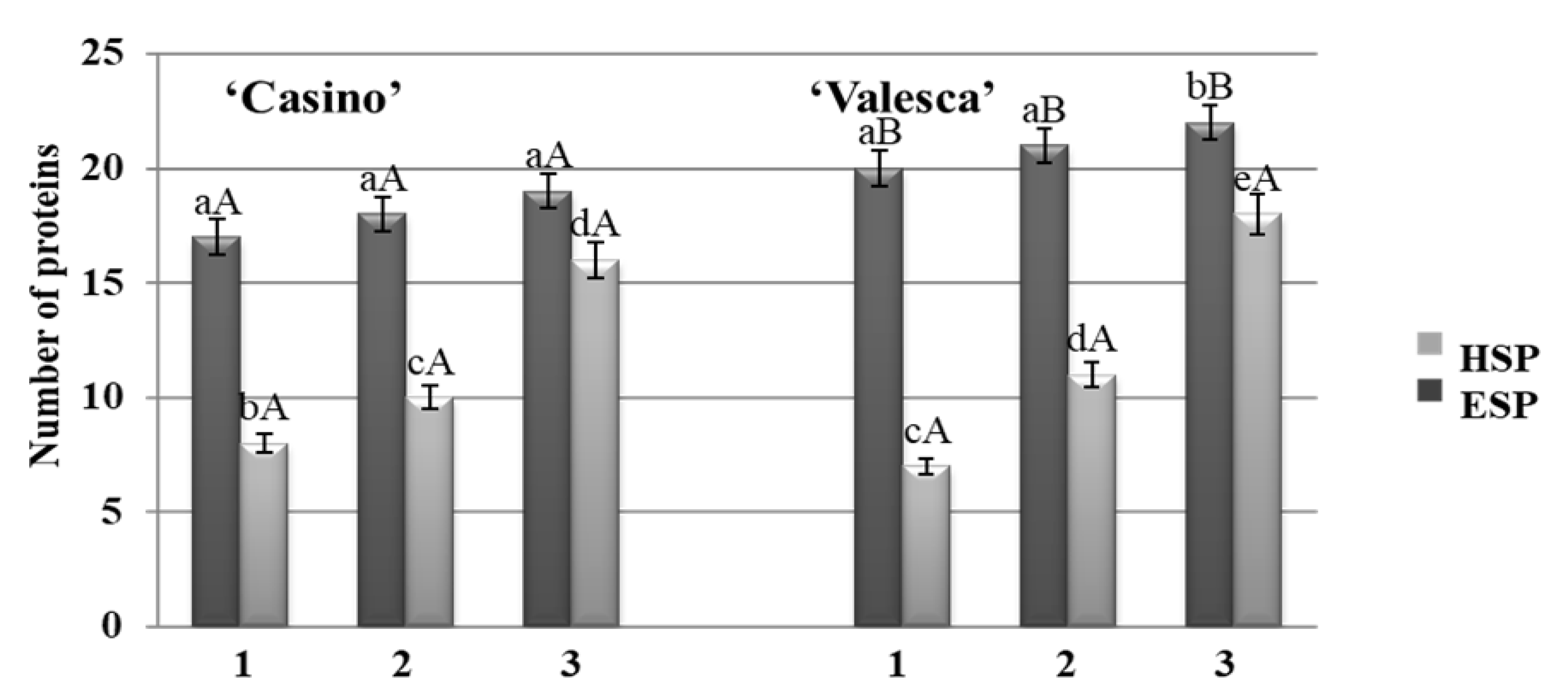
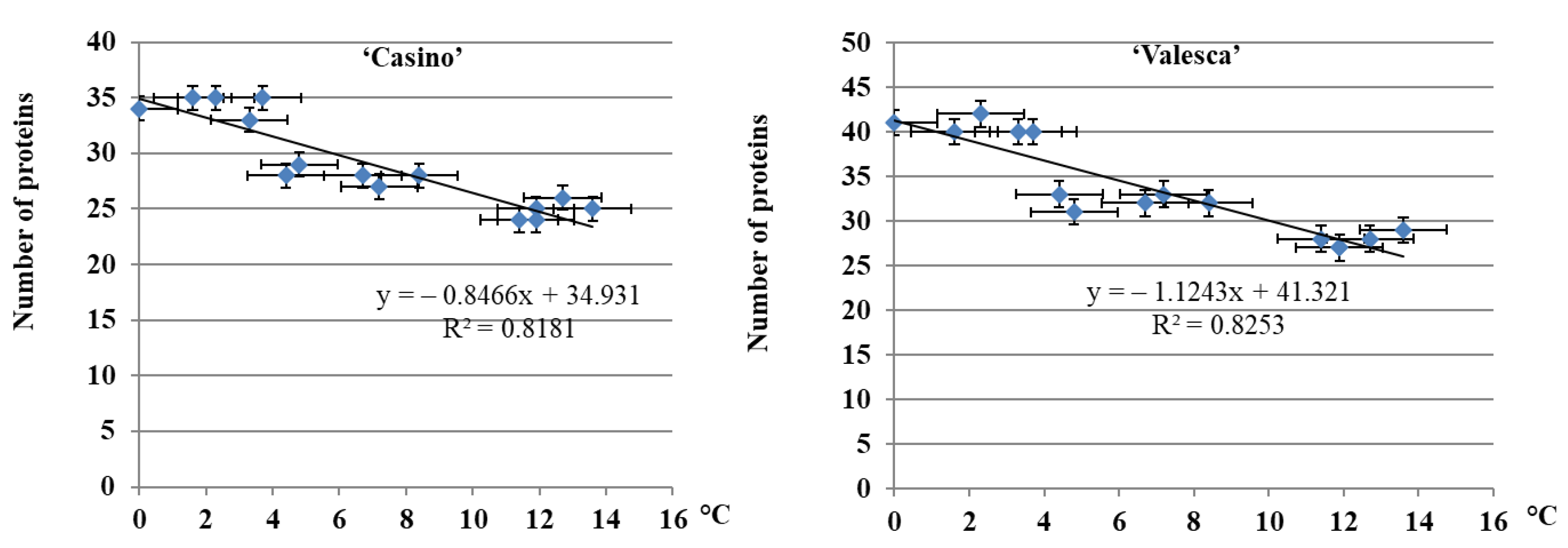
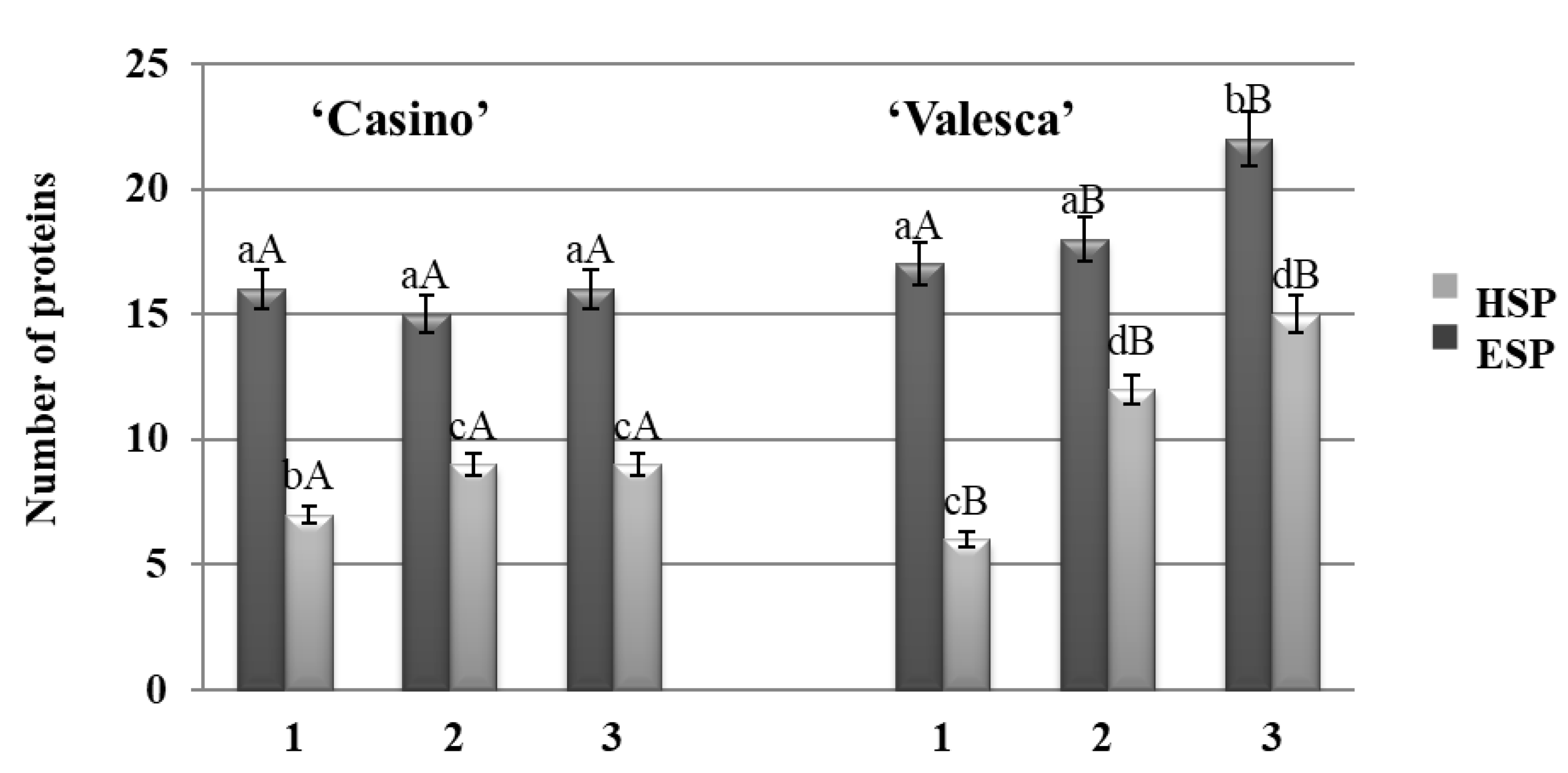







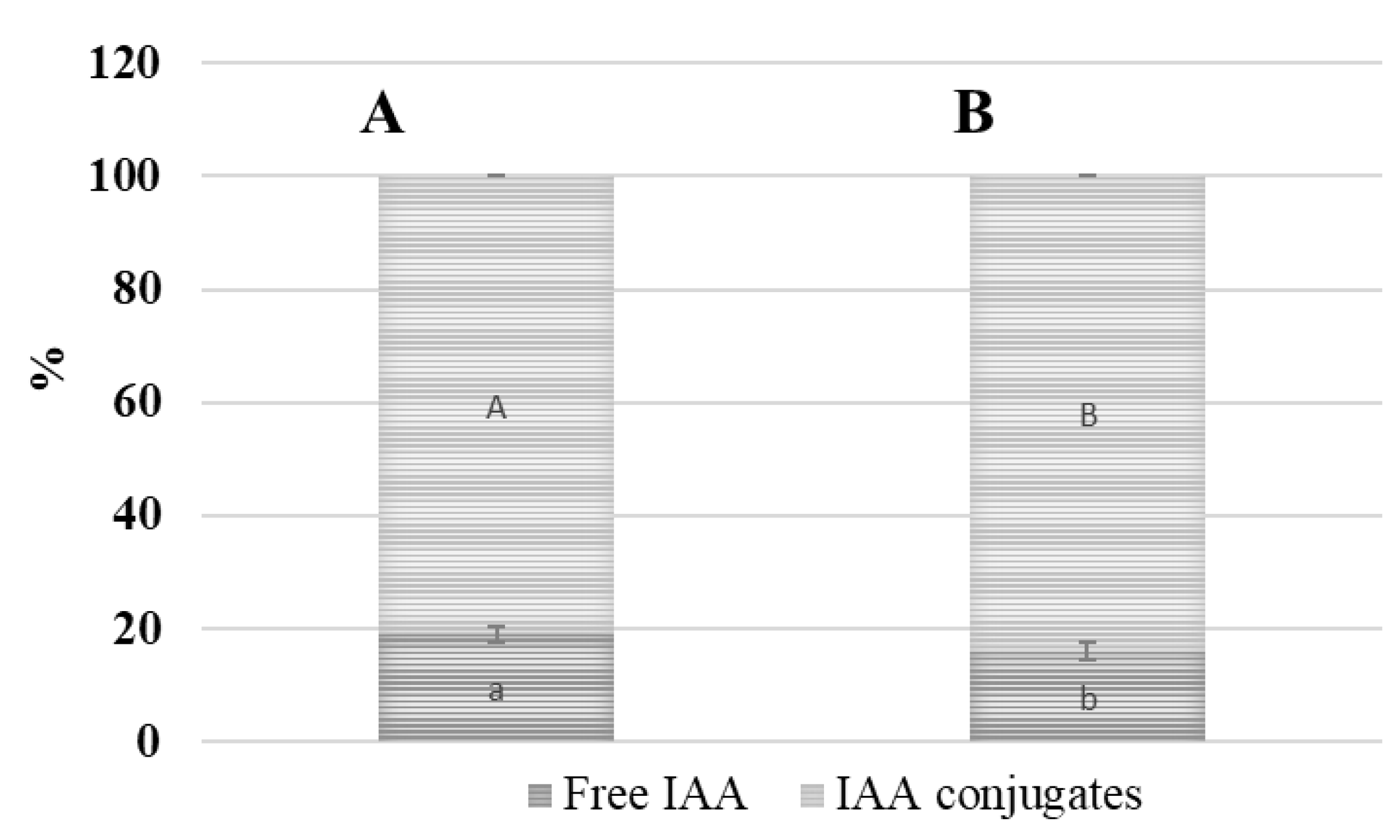


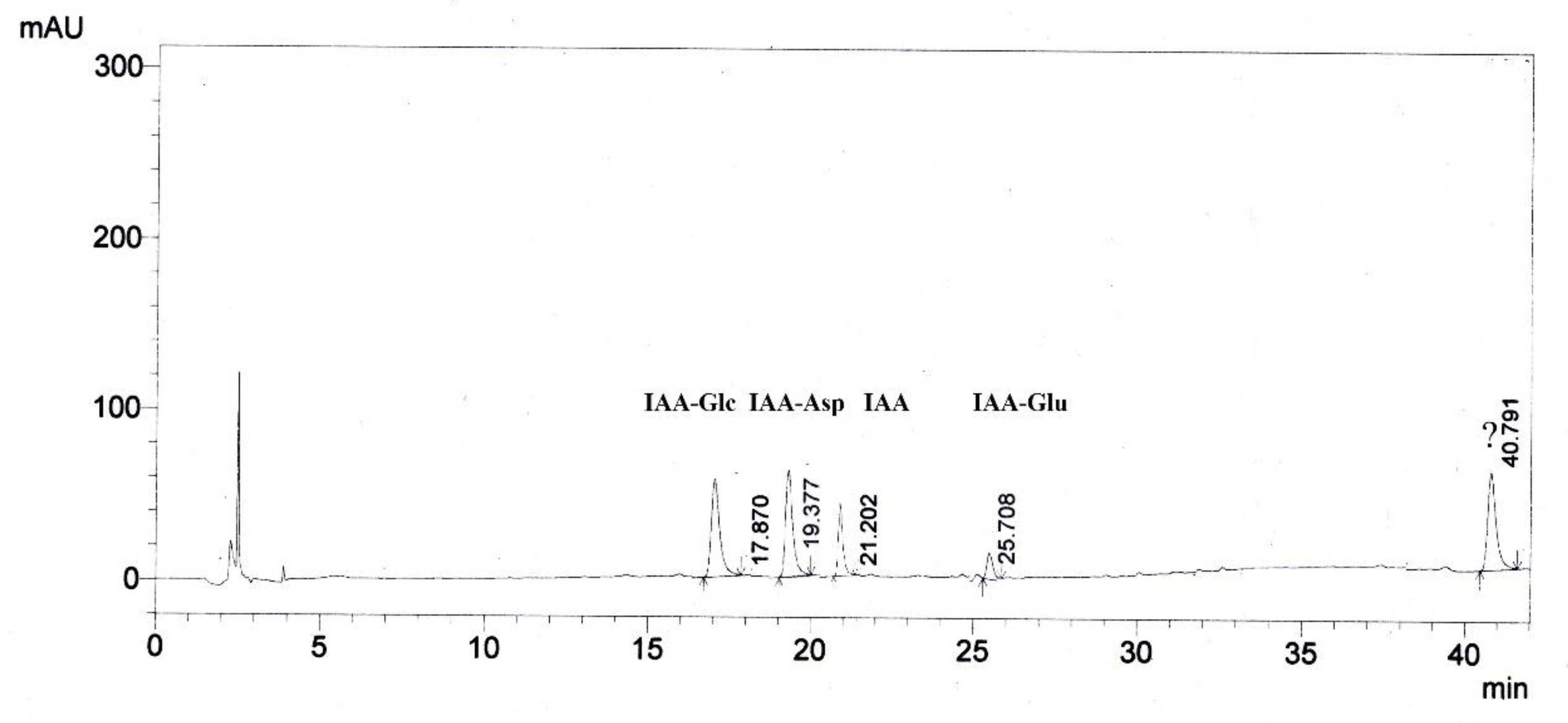

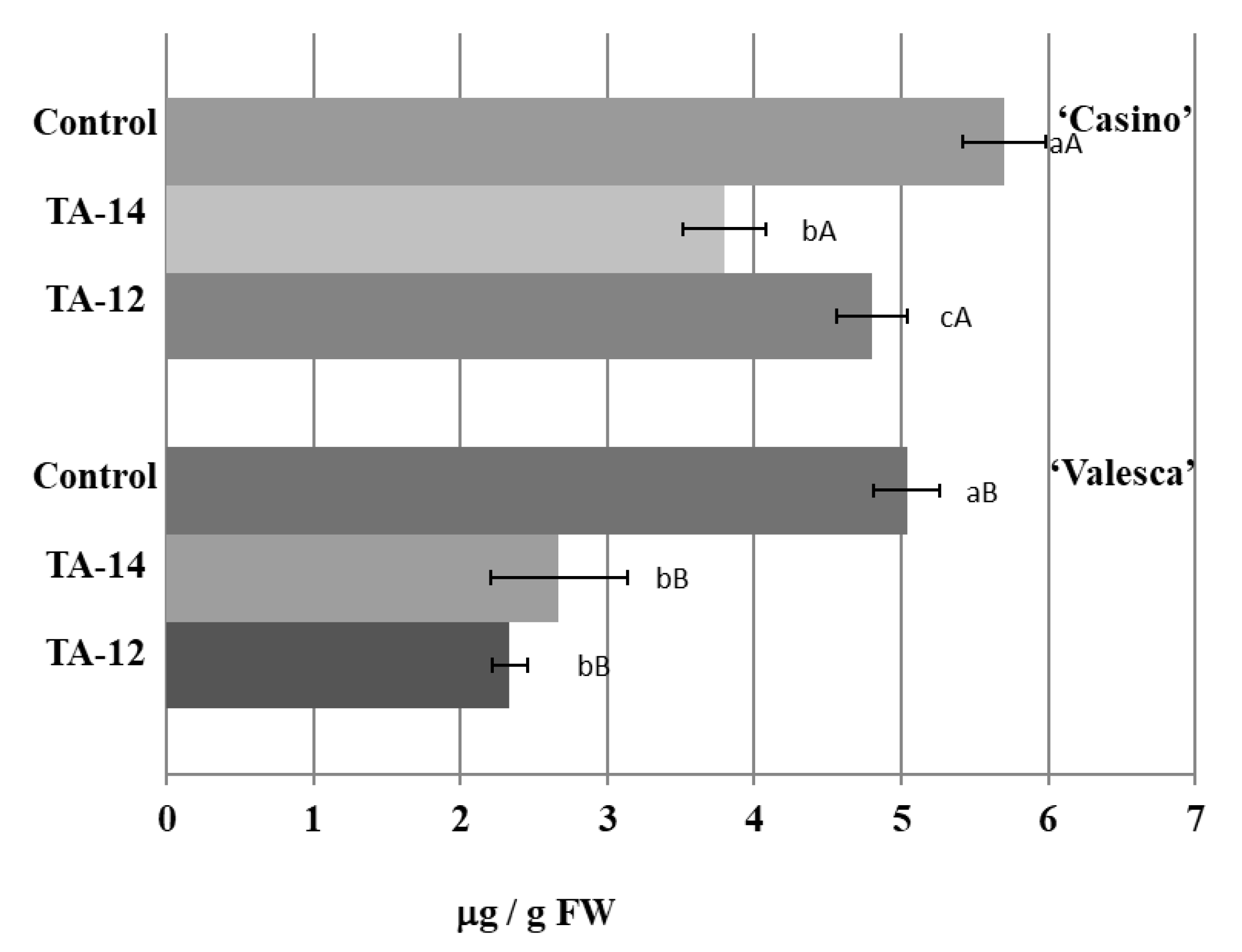
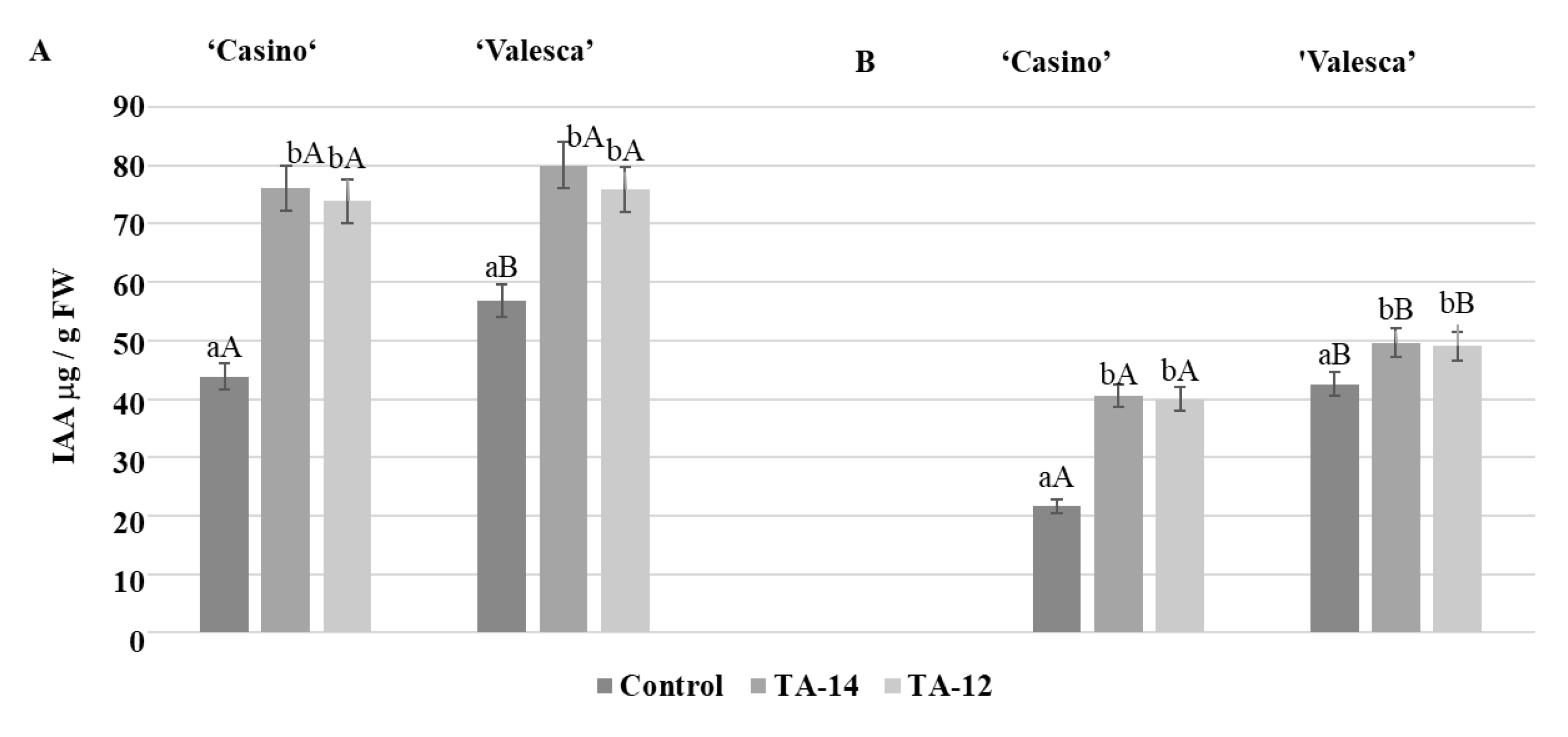

| Organ | Protein | Oilseed Rape Cultivars | |
|---|---|---|---|
| ‘Valesca’ | ‘Casino’ | ||
| Terminal bud | Disappeared | 25.80 ± 0.20 aA | 31.15 ± 2.15 aB |
| Newly formed | 37.25 ± 2.25 bA | 40.63 ± 3.13 bA | |
| Remaining the same | 36.95 ± 2.05 cA | 28.23 ± 0.98 cB | |
| Root collar | Disappeared | 16.91 ± 2.09 aA | 25.21 ± 5.40 aB |
| Newly formed | 38.12 ± 2.52 bA | 32.25 ± 1.25 bB | |
| Remaining the same | 45.03 ± 0.13 cA | 42.50 ± 1.15 cB | |
| Oilseed Rape Cultivars | Organs | Fraction | |
|---|---|---|---|
| ESP, kDa | HSP, kDa | ||
| ‘Casino’ | Terminal bud | 89 | 96; 20 |
| Root collar | 46; 28 | 32 | |
| ‘Valesca’ | Terminal bud | 119; 48; 47; 43; 42 | 91; 59; 49; 39; 37; 28; 24; 18; 10; 8 |
| Root collar | 250; 55; 37; 17; 10; 8; 9 | 150; 75; 65; 24; 12; 10 | |
| Growth and Cold Acclimation Periods | Organs | Oilseed Rape Cultivars | |
|---|---|---|---|
| ‘Casino’ | ‘Valesca’ | ||
| Autumn growth | Terminal bud | 9.53 ± 2.83 aA | 16.73 ± 2.06 aB |
| Root collar | 12.60 ± 1.06 cA | 16.73 ± 2.92 cB | |
| The end of cold acclimation | Terminal bud | 35.76 ± 3.43 bA | 48.19 ± 4.44 bB |
| Root collar | 37.45 ± 1.65 dA | 51.78 ± 7.61 dB | |
| Test Variant | ‘Casino’ | ‘Valesca’ |
|---|---|---|
| Control | 4.35 ± 0.13 aA | 4.76 ± 0.18 cB |
| TA-14 | 6.21 ± 0.24 bA | 6.40 ± 0.30 dA |
| TA-12 | 6.23 ± 0.23 bA | 6.33 ± 0.50 dA |
Publisher’s Note: MDPI stays neutral with regard to jurisdictional claims in published maps and institutional affiliations. |
© 2022 by the authors. Licensee MDPI, Basel, Switzerland. This article is an open access article distributed under the terms and conditions of the Creative Commons Attribution (CC BY) license (https://creativecommons.org/licenses/by/4.0/).
Share and Cite
Jankauskienė, J.; Mockevičiūtė, R.; Gavelienė, V.; Jurkonienė, S.; Anisimovienė, N. The Application of Auxin-like Compounds Promotes Cold Acclimation in the Oilseed Rape Plant. Life 2022, 12, 1283. https://doi.org/10.3390/life12081283
Jankauskienė J, Mockevičiūtė R, Gavelienė V, Jurkonienė S, Anisimovienė N. The Application of Auxin-like Compounds Promotes Cold Acclimation in the Oilseed Rape Plant. Life. 2022; 12(8):1283. https://doi.org/10.3390/life12081283
Chicago/Turabian StyleJankauskienė, Jurga, Rima Mockevičiūtė, Virgilija Gavelienė, Sigita Jurkonienė, and Nijolė Anisimovienė. 2022. "The Application of Auxin-like Compounds Promotes Cold Acclimation in the Oilseed Rape Plant" Life 12, no. 8: 1283. https://doi.org/10.3390/life12081283
APA StyleJankauskienė, J., Mockevičiūtė, R., Gavelienė, V., Jurkonienė, S., & Anisimovienė, N. (2022). The Application of Auxin-like Compounds Promotes Cold Acclimation in the Oilseed Rape Plant. Life, 12(8), 1283. https://doi.org/10.3390/life12081283







